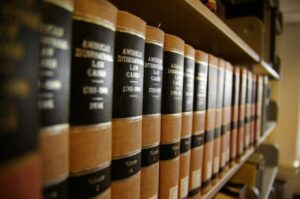This post deals with issues involving evidence and civil procedure. Lawyers get excited by these issues (Ok, maybe not, but perhaps a refresher will help) but if you are not a lawyer don’t read this unless you want to fall asleep fast, in which case knock yourself out. We start with a little evidence refresher dealing with authentication and foundation issues including voice identification, handwriting, emails, and photos, followed by an update on the use of requests for admission.
Evidence Refresher

Authentication and Foundation
Kansas law in K.S.A. 60-464 provides that authentication of a writing is required before it may be received in evidence and provides, further, that this may be accomplished by evidence sufficient to sustain a finding of its authenticity or by any other means provided by law. The issue with authentication is whether a writing is what it is claimed to be.
The proper objection would be, “Objection, no foundation has been established.” You must always object at the time, or the objection will be waived.
As a practical matter, most foundation issues can be agreed to in advance by the parties in a joint stipulation, with the Subpoena for Business Records (cp. https://www.kansasjudicialcouncil.org/legal-forms/civil-actions/chapter-60/subpoenas/ksa-60-245a-subpoena-nonparty-business-records ) followed up with an adequately phrased Request for Admission, with a stipulation in the Pretrial Order.
Foundation for a voice identification in a recording requires that the witness heard the voice, and from his or her familiarity with the speaker’s voice is of the opinion (there is no requirement he or she be an expert) that it belongs to the speaker.
Federal Rules of Evidence 901(b) sets out examples of testimony that would establish authentication.
The authenticity of a handwriting can be proved by someone who saw the author write the handwriting or is familiar with the author’s past writings or by indirect evidence. What about a Facebook page? State v. Jones, a Kansas case said:
“Printouts of web pages must first be authenticated as accurately reflecting the content of the page and the image of the page on the computer at which the printout was made before they can be introduced into evidence. Then, to be relevant and material to the case at hand, the printouts often will need to be further authenticated as having been posted by a particular source. See Smoot, 316 Ga.App. at 109–110(4)(a). State v. Jones, 318 P.3d 1020 (Kan. Ct. App. 2014)”
In Jones, the ex-wife testified she was familiar with the Facebook page, often communicated using it, and she had seen the posts on the page. The court said other issues as to whether the defendant authored the posts included a question about the weight of the evidence, not admissibility.
What about emails? The best evidence rule is satisfied by a printout. See FRE 1001(d). More importantly, the federal rule specifically contemplates that “[f]or electronically stored information, ‘original’ means any printout—or other output readable by sight—if it accurately reflects the information. State v. Robinson, 303 Kan. 11, 222, 363 P.3d 875, 1019 (2015), provided there is no genuine dispute regarding authenticity. (“e-mail offers unique opportunities for fabrication, [but] it is held to the same standards of authentication as other similar evidence”); Commonwealth v. Purdy, 459 Mass. 442, 450, 945 N.E.2d 372 (2011)
State v. Robinson, 303 Kan. 11, 224, 363 P.3d 875, 1021 (2015), disapproved of by State v. Cheever, 306 Kan. 760, 402 P.3d 1126 (2017)
The State proffered Remington’s testimony outside the presence of the jury to authenticate these exhibits. Based on her independent recollection, Remington testified that State’s Exhibits 4 and 5 were printouts from her home computer of e-mails she received from and sent to Robinson when he was posing as Trouten. She confirmed the content of the messages were true and accurate and that she did not alter them. Based on this testimony, the State adequately authenticated State’s Exhibits 4 and 5.
State v. Robinson, 303 Kan. 11, 226, 363 P.3d 875, 1022 (2015), disapproved of by State v. Cheever, 306 Kan. 760, 402 P.3d 1126 (2017)
Kearley v. State, 843 So.2d 66, 70 (Miss.App.2002) (e-mails properly authenticated where witness vouched for accuracy of printouts); Shea v. State, 167 S.W.3d 98, 105 (Tex.App.2005) (e-mails authenticated where complaining witness testified *227 she was familiar with the defendant’s e-mail and received the messages from him); Tibbetts v. RadioShack Corp., No. 03–C–2249, 2004 WL 2203418, at *13 (N.D.Ill.2004) (unpublished opinion) (copies of e-mails authenticated by sales manager’s testimony they were true and accurate copies); see also Annot., 34 A.L.R. 6th 253 (Authentication of Electronically Stored Evidence) § 2, pp. 269–70 (citing Mueller and Kirkpatrick, Federal Evidence § 9:9 [3d ed.] [witness who viewed original e-mail need testify only that the printout is an accurate reproduction] ).
State v. Robinson, 303 Kan. 11, 226–27, 363 P.3d 875, 1022 (2015), disapproved of by State v. Cheever, 306 Kan. 760, 402 P.3d 1126 (2017)
What about Photos? The person who takes a photo need not be the person who identifies it, State v. Pruitt, 42 Kan. App. 2d 166, 211 P. 3d 166 (2009). So, it’s sufficient for the witness to testify that the photo of injuries correctly represents his injuries on this night and that the photos were taken the following day.
- I show you what has been marked as Exhibit 2. What is depicted in that photograph?
- A stoplight at the intersection of 4th and Pine.
- Is that photograph a fair and accurate representation of the stoplight at 4th and Pine as it existed on the day of the collision?
- Yes, it is.
You can move for admission of the photograph into evidence.
What if something about the scene depicted in the photograph has changed since the date of the collision? In the example above, for example, what if the crash occurred on a snowy day, but the photograph was taken on a day without snow?
If you are using the photograph not to demonstrate the ground cover, but the position of the stoplight, ask the second question like this: “With the exception of absence of snow from the ground, is the photograph marked as Exhibit 2 for identification a fair and accurate representation of the intersection at 4th and Pine on the date of the collision?”
If evidence is excluded, make a proffer using K.S.A. 60-405 to preserve the issue on appeal.
Source: James W. Jeans, Trial Advocacy p. 11.6 (West 1975), Kansas Evidence Objections, Michael Am Barbara, and Kansas Law and Practice, Barbara.
Hearsay: A Refresher

Let’s consider the question of what hearsay is. The basic definition as set out in K.S.A. 60 – 460.
When a witness testifies something like, “She told me,” or “I heard her say,” or “I saw him pointing at the red card,” then you should be alerted to the possibility of hearsay.
As a practical matter, you do not always have to make the hearsay objection. Make the objection only if you feel the testimony will hurt your case.
Only declarative statements fall within the hearsay rule as they are assertions of facts, whether verbal or non-verbal. To determine whether an out-of-court statement is offered for its truth, it is necessary to consider the substance of the statement and then the relevant purpose for which the statement is offered. If they coincide, it is assumed that the statement is offered to prove the truth of the matter asserted. If an utterance previously made out-of-court is being offered merely to show what was said and not to assert that the content of the statement was true, then the testimony is not considered hearsay; therefore, questions, explanations, or imperatives may not be included in the rule. State vs. Becker, 290 Kansas 842 (2010). Out-of-court statements involving libel and slander are good examples of testimony not offered to prove the truth of the matter but only to show that the words were written or said. Also, a statement made out-of-court can be admitted for the purpose of proving the effect on the listener. Alternatively, an out-of-court statement can be offered not to prove the truth of the matter asserted but to explain an officer’s conduct.
If there’s more than one purpose for a particular statement, it may be offered for the nonhearsay purpose. Statements containing express assertions may also contain implied assertions qualifying as hearsay and subject to hearsay objections.
If an out-of-court statement is admitted because it is nonhearsay, the objecting party should make a request of the court to instruct the jury of its limited purpose at the time of its admission and in the written instructions that it’s not being offered to prove the truth of the matter asserted.
Evidence of discordant marital relations is admissible in a marital homicide case.
In approaching hearsay and attempting to determine if it is hearsay, you ask two questions:
- Is there an assertion, verbal or nonverbal, made outside the courtroom?
- If so, is it being offered to prove the truth of the matter asserted? If so, then it is hearsay and isn’t admissible unless it falls within one of the statutory exceptions.
Kansas has about 33 exceptions to the hearsay rule. The first one is for people present at the hearing and available for cross-examination, an exception not found in the Federal rule.
These concepts came from, Kansas Law and Practice, Barbara.

Requests for Admissions
The following will review some of the legal standards dealing with Requests for Admissions in a civil lawsuit, specifically whether Request for Admissions can be used for legal conclusions. Spoiler: No, however you can ask for admissions that involve the application of law to fact or opinions about either. The cases deal with Federal Rule 36 but most states have a similar rule. (click here for the Kansas rule)
In a personal injury lawsuit much time is spent in “discovery”. This means there are tools that the lawyers can use to find out what the evidence will show prior to going to trial. Your lawyer can use written questions called interrogatories, depositions, request for production or under Rule 36 of the Federal Rules of Civil Procedure he or she can use requests for admission regarding the application of law to fact but not requests regarding the trust of a purely legal conclusion. (See Disability Rights Council v. Wash. Metro. Area, 234 F.R.D. 1 (D.D.C. 2006)).
This case gave negative treatment to the Disability Council v. WMATA case, above, United States ex rel. Bibby v. Mortg. Inv’rs Corp., 323 F.R.D. 424 (N.D. Ga. 2017), pointing out that the drafters suggested that the rule does not authorize requests for admissions on law unrelated to the facts of the case. See the Advisory Committee Notes to the 1970 Amendment.
Normally you will find Requests for Admissions used to have the parties stipulate to certain facts so these facts need not be proved at the trial. This will allow the trial to focus on the real issues between the parties and save everyone time.
